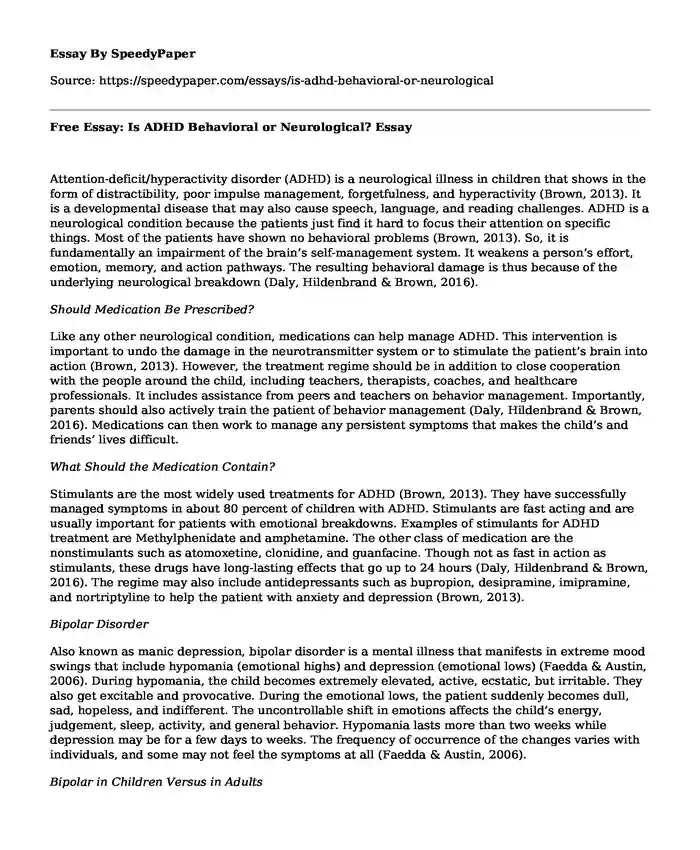
| Essay type: | Definition essays |
| Categories: | Child development Bipolar disorder Behavior change Essays by pagecount |
| Pages: | 3 |
| Wordcount: | 705 words |
Attention-deficit/hyperactivity disorder (ADHD) is a neurological illness in children that shows in the form of distractibility, poor impulse management, forgetfulness, and hyperactivity (Brown, 2013). It is a developmental disease that may also cause speech, language, and reading challenges. ADHD is a neurological condition because the patients just find it hard to focus their attention on specific things. Most of the patients have shown no behavioral problems (Brown, 2013). So, it is fundamentally an impairment of the brain’s self-management system. It weakens a person’s effort, emotion, memory, and action pathways. The resulting behavioral damage is thus because of the underlying neurological breakdown (Daly, Hildenbrand & Brown, 2016).
Should Medication Be Prescribed?
Like any other neurological condition, medications can help manage ADHD. This intervention is important to undo the damage in the neurotransmitter system or to stimulate the patient’s brain into action (Brown, 2013). However, the treatment regime should be in addition to close cooperation with the people around the child, including teachers, therapists, coaches, and healthcare professionals. It includes assistance from peers and teachers on behavior management. Importantly, parents should also actively train the patient of behavior management (Daly, Hildenbrand & Brown, 2016). Medications can then work to manage any persistent symptoms that makes the child’s and friends’ lives difficult.
What Should the Medication Contain?
Stimulants are the most widely used treatments for ADHD (Brown, 2013). They have successfully managed symptoms in about 80 percent of children with ADHD. Stimulants are fast acting and are usually important for patients with emotional breakdowns. Examples of stimulants for ADHD treatment are Methylphenidate and amphetamine. The other class of medication are the nonstimulants such as atomoxetine, clonidine, and guanfacine. Though not as fast in action as stimulants, these drugs have long-lasting effects that go up to 24 hours (Daly, Hildenbrand & Brown, 2016). The regime may also include antidepressants such as bupropion, desipramine, imipramine, and nortriptyline to help the patient with anxiety and depression (Brown, 2013).
Bipolar Disorder
Also known as manic depression, bipolar disorder is a mental illness that manifests in extreme mood swings that include hypomania (emotional highs) and depression (emotional lows) (Faedda & Austin, 2006). During hypomania, the child becomes extremely elevated, active, ecstatic, but irritable. They also get excitable and provocative. During the emotional lows, the patient suddenly becomes dull, sad, hopeless, and indifferent. The uncontrollable shift in emotions affects the child’s energy, judgement, sleep, activity, and general behavior. Hypomania lasts more than two weeks while depression may be for a few days to weeks. The frequency of occurrence of the changes varies with individuals, and some may not feel the symptoms at all (Faedda & Austin, 2006).
Bipolar in Children Versus in Adults
Bipolar disease has for long been majorly prevalent among adults, but its occurrence in children has recently been on the rise (Faedda & Austin, 2006). However, the manifestation in children has some stark differences from adults. Firstly, mania is the first stage of expression for adults while in children, bipolar begins with an intense depression (Diler, 2006). Also, adults experience the shifts occasionally, maybe a few times a year and the seasons are distinct with intervening sessions of wellness. In children, however, the shifts are continuous and the child may experience multiple cycles a day, running for several weeks or even months (Diler, 2006). Since bipolar in children comes at a critical developmental stage, its effects on the child’s life are more pronounced than in an adult’s life (Faedda & Austin, 2006).
Treatment for Bipolar Disorder
The treatment focuses on reducing the number of cycles and calming the severity of the seasons in a child to allow normal development to continue (Faedda & Austin, 2006). The regime includes the use of mood stabilizers like lithium and Depakene, antipsychotics like olanzapine and asenapine, antidepressants, antidepressant-antipsychotics such as fluoxetine and olanzapine combinations, and anti-anxiety medications such as benzodiazepines (Diler, 2006).
References
Brown, T. (2013). A new understanding of ADHD in children and adults. Routledge Publishers.
Daly, B. P., Hildenbrand, A., & Brown, R. T. (2016). ADHD in Children and Adolescents. Deutschland: Hogrefe Publishing.
Diler, R. S. (2006). Pediatric bipolar disorder: A global perspective. New York: Nova Science Publishers.
Faedda, G. L., & Austin, N. B. (2006). Parenting a bipolar child what to do and why. New Harbinger: Oakland, Calif.
Cite this page
Free Essay: Is ADHD Behavioral or Neurological?. (2023, Nov 14). Retrieved from https://speedypaper.net/essays/is-adhd-behavioral-or-neurological
Request Removal
If you are the original author of this essay and no longer wish to have it published on the SpeedyPaper website, please click below to request its removal:
- Essay Sample - Ekphrastic Poem Response
- Organizational Goals Essay Sample
- Essay Example about Chretien's Foreign Policy
- Essay Sample Claiming Marijuana Should Not Be Legalized
- Free Essay on the New Historicism and Its Application to Literature
- Free Essay Sample on Urban Sprawl
- Essay Sample on Solutions to the Potential Vulnerabilities in Different Network Systems
Popular categories




